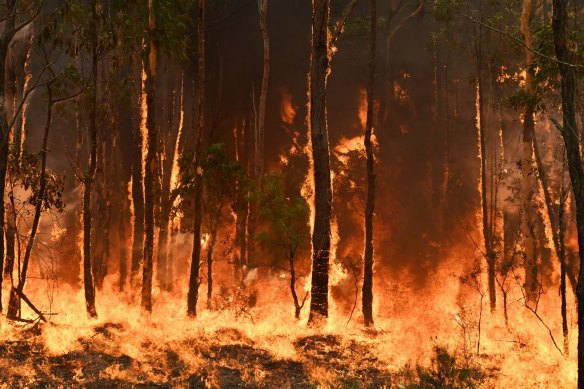Beyond Compliance: Enhancing Residential Or Commercial Property Security with a Thorough BAL Report Analysis
Beyond Compliance: Enhancing Residential Or Commercial Property Security with a Thorough BAL Report Analysis
Blog Article
Ensuring Shrub Fire Security Through Proper BAL Record Evaluation
In the world of bush fire defense, the precise evaluation of Bushfire Attack Level (BAL) records stands as a foundation for safeguarding residential or commercial properties versus the terrible effect of wildfires. With ecological factors and building features playing considerable duties in determining the degree of risk, a detailed understanding of BAL ratings becomes necessary.
Recognizing Bushfire Attack Level (BAL)
In the world of bushfire defense, understanding the Bushfire Assault Degree (BAL) is paramount for making certain reliable mitigation techniques. Comprehending the BAL score of a property is essential for property builders, proprietors, and policymakers to execute appropriate actions to secure against bushfire hazards.

Relevance of BAL Record Evaluation
An essential element in bushfire protection planning entails the thorough evaluation of BAL reports to evaluate the potential threats and figure out suitable reduction approaches. BAL reports provide crucial details regarding the potential influence of bushfires on a building based upon different factors such as plant life kind, distance to possible fire risks, and incline of the land. Assessing these reports with accuracy is vital in developing reliable bushfire security actions customized to the certain threat profile of a building.
Executing Fire Security Actions
Executing efficient fire protection procedures is essential for guarding buildings in bushfire-prone areas. Among the key methods to boost fire protection is by producing defensible room around buildings. This entails clearing up flammable plant life, such as dry leaves and branches, within a specific distance of the building. Additionally, setting up fireproof roofing materials can assist lower the risk of cinders sparking the roof during a bushfire. Appropriately preserved screens and gutters are likewise vital to prevent debris buildup that might sustain a fire.
Additionally, having a properly maintained and sufficient water supply, such as a container or pool, can aid firefighters in their initiatives to safeguard the building. BAL Report. Generally, implementing a combination of these fire security measures can substantially increase the opportunities of safeguarding buildings during why not try this out bushfire occasions.
Mitigating Threats in Fire-Prone Areas
To strengthen homes versus bushfire dangers, a strategic focus on mitigating threats in fire-prone locations is critical. Mitigating risks in fire-prone areas entails a comprehensive method that incorporates various measures to lower the likelihood and effect of bushfires. One critical facet of risk mitigation is preserving defensible area around properties by clearing flammable greenery, making sure sufficient spacing between trees and frameworks, and utilizing fireproof landscape design practices. Additionally, executing ember-proofing procedures such as setting up steel mesh displays on windows and covering roof cavities can help avoid cinder attacks and reduce the danger of area fires.
Moreover, constructing or retrofitting structures with fire-resistant materials and ensuring correct maintenance of roofs, seamless gutters, and outside cladding can considerably enhance the home's resilience to bushfires. Creating and exercising a bushfire emergency situation plan with all owners, including evacuation procedures and communication methods, is also essential in mitigating dangers check these guys out successfully. By adopting a positive method to risk reduction in fire-prone areas, residential property proprietors can better shield their assets and improve overall bushfire preparedness.
Ensuring Property Security and Strength
Guaranteeing the security and durability of residential or commercial properties in fire-prone areas requires an unfaltering dedication to robust precautionary procedures and critical preparation. Building safety and security starts with implementing effective steps to minimize fire risks.
Resilience, on the other hand, involves the capacity of a building to hold up against and recoup from a bushfire. This can be improved with the setup of ember guards on home windows and vents, guaranteeing that access factors for cinders are minimized. In addition, having a well-balanced emptying plan and practicing it routinely can dramatically increase property strength. Working together with neighbors and regional fire authorities can also strengthen the security and strength of buildings in fire-prone areas. By proactively resolving these elements, property owners can much better safeguard their properties and loved ones from the hazard of bushfires.
Verdict
In conclusion, guaranteeing bushfire defense with proper BAL record evaluation is important for recognizing the degree of risk positioned by bushfires and carrying out essential fire protection steps. By alleviating threats in fire-prone locations and guaranteeing building safety and resilience, neighborhoods and individuals can better get ready for and react to bushfire occasions. It is essential to prioritize fire safety and security measures to safeguard lives and home in these risky atmospheres.
In the realm of bush fire security, the careful evaluation of Bushfire Assault Level (BAL) reports stands as a foundation for securing residential properties versus the devastating impact of wildfires (BAL Report). Understanding the BAL rating of a property is crucial for residential or commercial property policymakers, contractors, and proprietors to apply proper steps to safeguard versus bushfire dangers

BAL records give crucial information about the potential impact of bushfires on a home based on different aspects such as plants kind, distance to potential fire hazards, and slope of the land (BAL Report). Overall, implementing a combination of these fire protection measures can dramatically increase the chances of go now safeguarding residential or commercial properties during bushfire occasions
Report this page